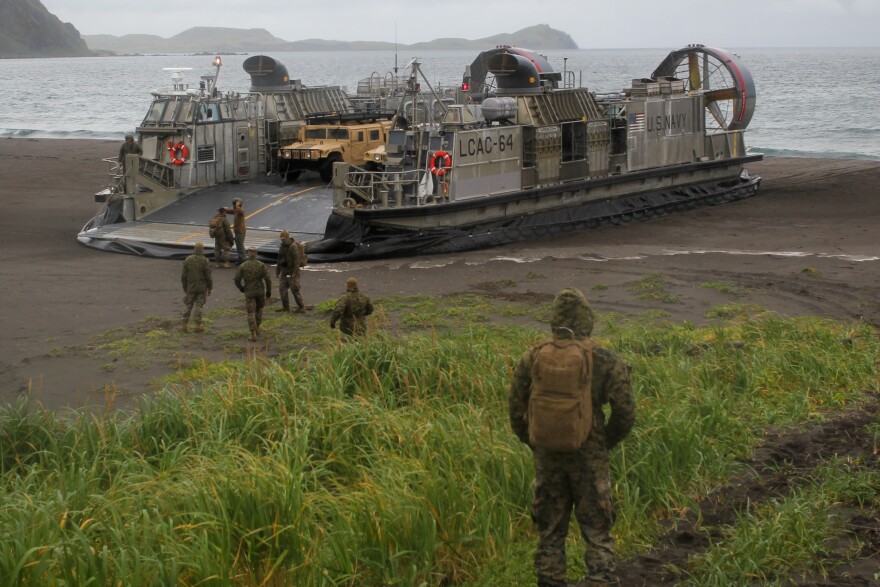The Pentagon is preparing for potential missions in newly navigable Arctic seas, raising hopes the military will reinhabit a long-abandoned Navy base on an Alaskan island.
As wind and rain alternately pummeled the shore, a hovercraft the size of a basketball court carried Marines and heavy equipment across the frigid Bering Sea. In September, for the first time in more than 30 years, the Navy and Marine Corps tested their capabilities in the extreme environment of Alaska's far flung Aleutian Islands.
Even the relatively mild autumn weather proved to be a challenge, as troops were tested with the mock seizure of an airfield in the small community of Adak.
"You can't simulate this," said Rear Admiral Cedric Pringle on the beach, doing his best to talk through stinging gusts of wind.
Pringle is in charge of 15,000 Navy seamen and Marines, many of whom were in Alaska for the first time as part of the Arctic Expeditionary Capabilities Exercise. The troops normally train in southern California and were brought to Adak to see how they would fare in a wetter, colder climate.
"From a Navy-Marine stand point, we looked at this exercise as an opportunity to conduct training in a very, very challenging environment," Pringle said.
The exercise is part of a trend. As climate change shrinks sea ice in the Arctic, previously frozen waters are opening to maritime shipping. Meanwhile, the U.S. military is preparing for potential missions in the newly navigable seas, as geopolitical rivals like Russia and China ramp up commercial activity.
And for Adak, one of the most secluded communities in the country, the Pentagon's renewed interest is viewed as a major opportunity.

A town left behind by the military
Even by Alaska standards, Adak is unique. It was massively built up during World War II as a staging ground for the American military campaign to dislodge Japanese forces from the northern Pacific.
During the Cold War, the island hosted a naval air station, submarine base, and 6,000 servicemembers and families. There were barracks and bunkers, but also schools, a bowling alley, and even a McDonald's.
But in the 1990's, the Pentagon closed the Adak base, abruptly leaving behind the infrastructure for a whole town. Only about 120 residents remain.
According to Adak Vice-Mayor Carrie Plant, many visitors' first impression of the town is the stark juxtaposition.
"The combination of the incredible physical beauty," she said, "combined with the urban decay of so many buildings that are falling apart."
On the north side of the island, where most of the town's buildings and infrastructure are, that eerie combination is on full display. There are cul-de-sacs of prefabricated houses from different eras, some occupied, many shuttered, and plenty in various states of collapse, with whole walls and floors missing.
Plant doesn't like when outsiders use the term "ghost town" to describe Adak, because she says that belies all the hard work by residents to grow a strong, entrepreneurial community in the remnants of the former base.
Residents are hoping the military's potential return to Adak will give the town a boost. Many people in Adak wish the armed services will re-establish a permanent presence.
Paul Fuhs is a military liaison for the Aleut Corporation, an Alaska Native company that owns much of Adak's land. His job is to convince the Navy of Adak's unique appeal, including an abundance of weather-ravaged buildings to use in urban warfare training.
"The windows are broken, it's dark, there's tunnels, hidey holes, booby traps. I mean that's what they want," Fuhs said.

Hope for a renewed community
More than a thousand troops took part in the September exercise in Adak, which included the helicopter assault, amphibious assault vehicles storming a beach, and underwater mine countermeasures. The drills in Adak had a complementary element in the southcentral Alaska port town of Seward. And they followed a rare visit by an aircraft carrier during separate summer training exercises in the Gulf of Alaska.
Changes in the military's footprint in the region are far from certain. Asked whether the Navy has plans to re-establish a permanent presence on Adak, Lt. Rochelle Rieger, a spokeswoman for the 3rd Fleet wrote, "the specifics are pre-decisional at this point."
Meanwhile, Vice-Mayor Plant says that while no one expects the base will return to the size it was in the 90s, she's optimistic that enough military personnel might come back to help the town keep transforming.
"Something a lot of people in Adak would hope for is that there’s families, not just individual workers or individual soldiers," Plant said, stressing that children in particular would make a meaningful difference. "Being a community and not just a work camp."
This story was produced by the American Homefront Project, a public media collaboration that reports on American military life and veterans. Funding comes from the Corporation for Public Broadcasting.




